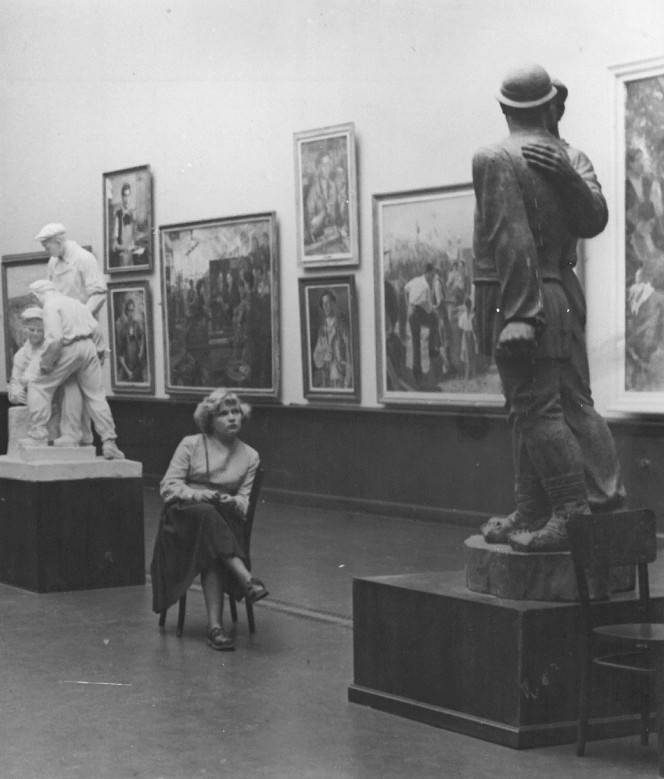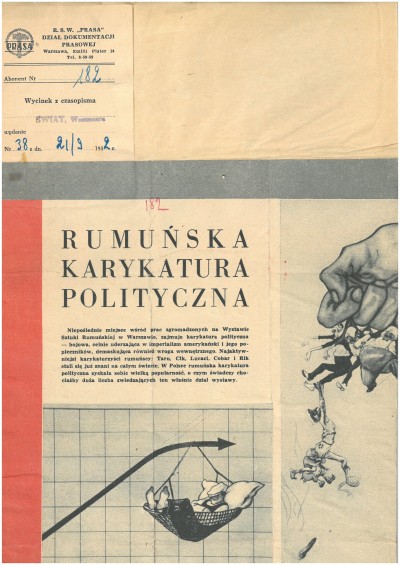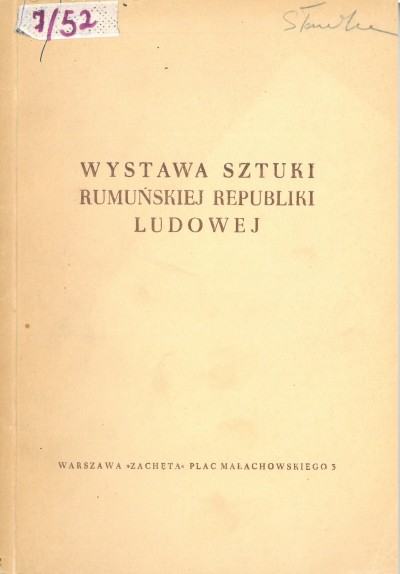Exhibition of Art from the Romanian People's Republic
14.08 – 20.09.1952 Exhibition of Art from the Romanian People's Republic
Zachęta Central Bureau of Art Exhibitions (CBWA)
Zachęta Central Bureau of Art Exhibitions (CBWA)
organiser: Committee for Cultural Cooperation with Foreign Countries
attendance: 21,735
The Exhibition of Art of the Romanian People’s Republic was a part of a series of exhibitions at the Central Bureau of Art Exhibitions in the 1950s, presenting the art of people’s democracies, in accordance with the programme implemented by the Committee for Cultural Cooperation with Foreign Countries. It was one of the exhibitions envisioned to substantiate the thesis that the aesthetics of Socialist Realism were a logical consequence of realistic trends that had been developing for centuries in people’s democracies.
The exhibition at the CBWA filled six rooms and featured paintings, sculptures and graphics (74 paintings, 35 sculptures, 157 drawings, fabrics and tapestries.) Apart from professional art, folk art has also had its place at the exhibition. In line with the organisers’ assumptions, the audience could explore the history and everyday life of Romania in recent years on the basis of the presented works. Stolica wrote: ‘The emergence of great historical compositions that celebrate the heroic traditions of the nation’s struggle for freedom and a better life is of particular importance in the development of Romanian visual arts’.[1] The exhibition also featured landscapes and portraits, as well as themes from international Socialist Realist painting:[2] the struggle of French dockers dropping American weapons into the sea and the war in Korea.
Particularly noteworthy was the painting presenting the French dockers. A journalist from Przegląd Kulturalny described it as follows: ‘The spirit of the fight, which fills the group of dockers enclosed in a triangular field, is raised by the skilful use of the very French port landscape. Above the steel structure of the port cranes on the left and houses on the right, the viewer can see the sky, heavy with the clouds coming in from the Atlantic. Any deficiencies in this painting pale in the view of its entirety, reinforced by a firm, consistent depiction of the group and the landscape in one silver and grey tone, which undoubtedly presents the atmosphere of the port.’[3] In Poland, a similar painting was painted by Wojciech Fangor, which was pointed out by Jan Lenica (‘an interesting painting, particularly when compared to similar compositions by our painters, such as Fangor’).[4] A few months earlier, at the Exhibition of Contemporary French Visual Arts at the CBWA, a picture by Gérard Singer dealing with this subject had also been presented. At that time, the canvas was purchased by the Polish government and can now be seen in the National Museum in Szczecin.[5]
The Romanian exhibition featured an extensive presentation of caricatures, compared to the exhibitions of foreign art organised by the Committee for Cultural Cooperation with Foreign Countries at the CBWA. According to the foreword to the catalogue, this kind of art ‘enjoyed particular popularity in Romania’. Ignacy Witz took up this subject in his review: ‘Romanian satire is a high-class art — accurate, sharp, apt, and spiteful’.[6] Jan Lenica also described this specificity of Romanian art in a similar tone: ‘The list of more than 100 works includes a selection of lively and combative political caricature, already known to Polish viewers from a special exhibition. The most active cartoonists, such as Taru, Cik, Lucaci, Cobar and Rik, who work on a regular basis with the Urzica satirical weekly are represented with a great number of works. . . . The ideas agitate the viewer with their accuracy. Some of these caricatures, such as the Toast and War Instigators Press, were reprinted in almost all democratic and progressive press around the world and were used as posters.’[7]
Contemporary art scholars and critics of the 1950s art point out the special status of caricature in the visual culture of the Socialist Realism era. According to Elżbieta Kal: ‘Let us note that, unlike the more liberal attitude towards the involved art of the West, Polish criticism of the works of the Soviet bloc countries had to be based on analogous doctrinal criteria. It was characterised by similar level of detail, expressions of satisfaction . . . combined with searching for and listing all kinds of formal and ideological deficiencies in great detail. Satirical art, which by its very nature was mostly conventional and sparse in its form, and the political, preferably anti-American, anti-Church and pro-Soviet nature of which ensured acceptance and approval, was treated less rigorously.’[8]
The design of the Romanian art exhibition was analogous to the design of the Exhibition of Works by Soviet Artists, also presented at the CBWA in 1951. The exhibition started on the Zachęta staircase, where an oil painting depicting Joseph Stalin was placed against a backdrop of draped fabric. Portraits of the general secretaries of the Polish and Romanian Communist parties hung on the sides. At the bottom, there were flowers and flags of the Polish People’s Republic, the Romanian People’s Republic and the Soviet Union.
The exhibition at the CBWA featured exhibits of Romanian folk art that were not included in the exhibition catalogue. The introduction highlighted that ‘Polish viewers are going to find numerous traces and connections between Romanian folk art and Polish folk art of the Podkarpacie and Podhale Regions’. Stefan Henel reported: ‘The folk costume section is literally teeming with colours, ornamental motifs and the abundance of compositions. We are almost jealous of the fact that Romanian folk costumes show much greater artistic inventiveness than ours.’[9] In his review, Józef Grabowski eagerly added that Romania has long been full of appreciation for folk art, and that a museum devoted exclusively to folk art was established in Bucharest, aptly named the Museum of National Art.[10] He also noted the ‘kinship of Romanian and Polish folk art, which have common points, in spite of enormous differences in their basic tones’.[11]
The general search for similarities did not concern only folk art. The aforementioned Henel argued with pathos: ‘In these works, we can find the same deep revolutionary current of the struggle for the rebuilding of the social and economic structure of the country, for the consolidation of peace in the world, for the fraternal coexistence of all peoples, which is common to all of us.’[12] However, he also noted some differences: ‘Undoubtedly, Romanian artists remember better than our own about the fact that there is no painting without colour.’[13]
Karolina Zychowicz
department of documentation of Zachęta — National Gallery of Art
This compilation was prepared as part of the National Programme for the Development of Humanities’ of the Polish Minister of Science and Higher Education — research project The History of Exhibitions at Zachęta — Central Bureau of Art Exhibitions in 1949–1970 (no. 0086/NPRH3/H11/82/2016) conducted by the Institute of Art History of the University of Warsaw in collaboration with Zachęta — National Gallery of Art.
Bibliography
Catalogue:
- Wystawa sztuki Rumuńskiej Republiki Ludowej, Malarstwo — rzeźba — grafika — sztuka ludowa. August–September 1952, Warsaw: Centralne Biuro Wystaw Artystycznych, 1952
Source texts:
- B. O. ‘Piękna wystawa sztuki rumuńskiej w Warszawie’. Słowo Tygodnia, no. 27, 1952, p. 2
- Grabowski, Józef. ‘Sztuka Ludowa Rumunii’. Słowo Powszechne, no. 230, 1952, p. 4.
- Henel, Stefan. ‘Barwy i sztuka Rumunii’. Express Wieczorny, no. 203, 1952, p. 3
- Lenica, Jan. ‘Sztuka Rumuńskiej Republiki Ludowej’. Trybuna Ludu, no. 255, 1952, p. 4
- Stec, Eugeniusz. ‘Wystawa malarstwa, rzeźby i grafiki rumuńskiej’. Przegląd Kulturalny, no. 4, 1952, p. 7
- Witz, Ignacy. ‘Sztuka rumuńska’. Życie Warszawy, no. 238, 1952
- ‘Wystawa sztuki rumuńskiej’. Stolica, no. 18, 1952, p. 11
Compilations:
- Kal, Elżbieta. ‘Krytyka a socrealizm satelitarny’, in „Tego się nie krytykuje, na kogo się nie liczy”. Polska krytyka artystyczna okresu realizmu socjalistycznego. Słupsk, 2010, pp. 292–299
- Zychowicz, Karolina. ‘The Exhibition-Organising Activity of the Comitee for Cultural Cooperation with Foreign Countries (1950–1956) Based on the Example of Selected Exhibitions at the Zachęta Central Bureau of Art Exhibitions’, trans. Klaudyna Michałowicz. Ikonotheka, no. 26, 2016, pp. 63–94
[1] ‘Wystawa sztuki rumuńskiej’, Stolica, no. 18, 15 September 1952.
[2] Regarding the different models of Socialist Realism, see: Jérôme Bazin, ‘Le réalisme socialiste et ses modèles internationaux’, Vingtième Siecle. Revue d’Histoire, no. 1, 2011, pp. 72–87.
[3] Eugeniusz Stec, ‘Wystawa malarstwa, rzeźby i grafiki rumuńskiej’, Przegląd Kulturalny, no. 4, 24 September–1 October 1952.
[4] Jan Lenica, ‘Sztuka Rumuńskiej Republiki Ludowej’, Trybuna Ludu, no. 255, 12 September 1952.
[5] Cf. Szymon Piotr Kubiak, Daleko od Moskwy. Gérard Singer i sztuka zaangażowana, Szczecin: Muzeum Narodowe w Szczecinie, 2016.
[6] Ignacy Witz, ‘Sztuka rumuńska’, Życie Warszawy, no. 238, 4 October 1952.
[7] Jan Lenica, ‘Sztuka Rumuńskiej Republiki Ludowej’, Trybuna Ludu, no. 255, 12 September 1952.
[8] Elżbieta Kal, ‘Tego się nie krytykuje, na kogo się nie liczy’. Polska krytyka artystyczna okresu realizmu socjalistycznego, Słupsk, 2010, p. 296.
[9] Stefan Henel, ‘Barwy i sztuka Rumunii’, Express Wieczorny, 1952, no. 203, p. 3.
[10] Józef Grabowski, ‘Sztuka Ludowa Rumunii’, Słowo Powszechne, no. 230, 1952, p. 4.
[11] Ibid.
[12] Henel.
[13] Ibid.
Exhibition of Art from the Romanian People's Republic
14.08 – 20.09.1952
Zachęta Central Bureau of Art Exhibitions (CBWA)
pl. Małachowskiego 3, 00-916 Warsaw
See on the map


